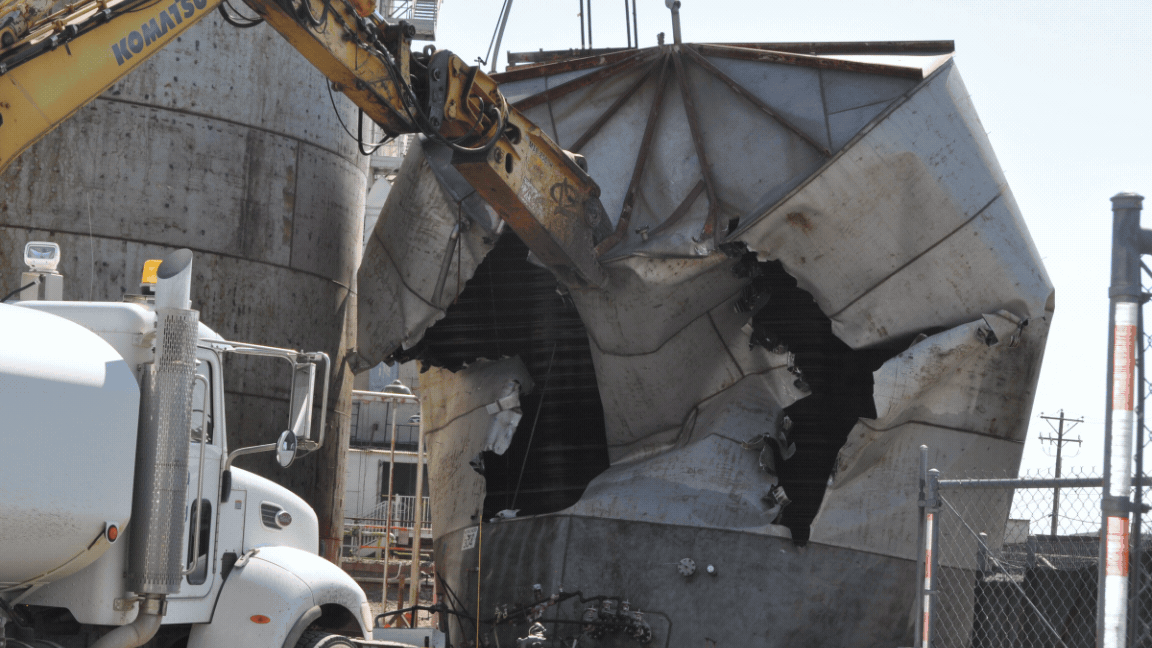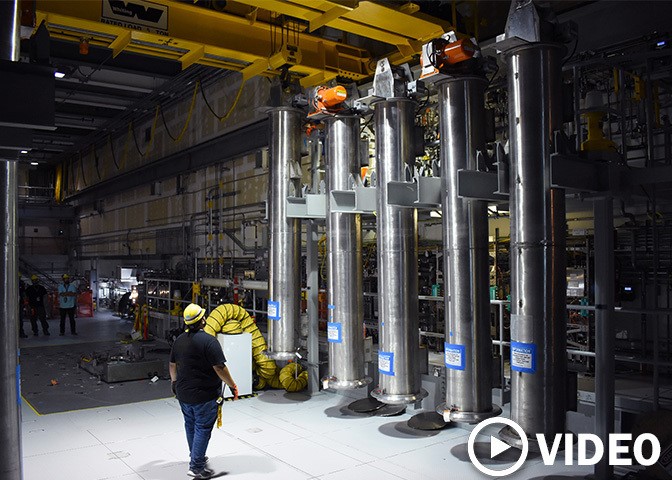Crews demolished a former chemical storage area at the Hanford Site’s Reduction Oxidation Plant. (Photos: DOE)
Workers with the Department of Energy Office of Environmental Management’s contractor Central Plateau Cleanup Company recently demolished a former chemical storage area at the Reduction Oxidation Plant, one of five former plutonium production facilities at the Hanford Site.
The Washington State University Tri-Cities campus. (Photo: WSU)
A new engineering scholarship at Washington State University (WSU) Tri-Cities has been established by Longenecker & Associates for students interested in careers that support Department of Energy missions.
A monitor in the control room of the Hanford Site’s TSCR system shows workers performing maintenance inside the TSCR facility. (Photo: DOE)
The Department of Energy Office of Environmental Management’s Office of River Protection and contractor Washington River Protection Solutions have completed the first waste processing campaign through the Tank-Side Cesium Removal (TSCR) system at the Hanford Site.
Some of the participants of the recent SRNL-Hanford Analytical Knowledge Sharing Workshop pause for a photo. (Photo: DOE)
A view of the Low-Activity Waste Facility at the Hanford Site. (Photo: DOE)
The National Academies of Sciences, Engineering and Medicine (NASEM) recently held a public meeting to discuss its third and final report centered on the Department of Energy’s Office of Environmental Management’s tank waste cleanup mission at the Hanford Site in Washington state.
This image of the PUREX plant was used to demonstrate how a 3D laser scanning tool could capture the layout of facilities being prepared for demolition. (Image: DOE)
A team of designers from Central Plateau Cleanup Company (CPCCo), a contractor of the DOE-EM Richland Operations Office, is using 3D laser scanning technology to gather data to help workers prepare some of the facilities at the Hanford Site for demolition.
Pictured at the DOE's EM headquarters, from left, are Ana Han, foreign affairs specialist, EM International Program; Joceline Nahigian, director, EM Office of Intergovernmental and Stakeholder Programs; Scott Whiteford, deputy director, DOE Office of Legacy Management; William “Ike” White, EM senior advisor; Masaki Nakagawa, special advisor to executive directors, NDF; Tokuhiro Yamamoto, executive director, NDF; Shin Morita, managing director, International Affairs Group, NDF; Taro Hokugo, managing director, International Affairs Group, NDF; Jeff Avery, EM principal deputy assistant secretary; Angela Watmore, deputy assistant secretary, EM Office of Acquisition and Project Management; and Ming Zhu, EM senior advisor for laboratory policy. (Photo: DOE)
Representatives from the Japan Nuclear Damage Compensation and Decommissioning Facilitation Corporation (NDF) recently visited the Department of Energy's Office of Environmental Management (EM) headquarters in Washington, D.C., and the Hanford Site in Washington state to promote collaboration and provide updates on the status and plans to decommission Japan's Fukushima Daiichi nuclear power plant. The Great East Japan Earthquake of March 11, 2011, caused damage to the plant and surrounding communities. The NDF was created in September 2011 to oversee the decommissioning and cleanup of the plant, which is owned by the Tokyo Electric Power Company.
Front face of the B Reactor at the Hanford Site. (Photo: DOE)
In remote southeastern Washington you will find the sprawling Hanford Site, which was constructed to produce plutonium for the Manhattan Project. Within this complex is the first plutonium production reactor, the Hanford B Reactor. The DuPont Corporation was responsible for construction and operation of the B Reactor. Due to the urgency of the Manhattan Project, construction was completed in just over a year, and The B Reactor went critical on September 26, 1944. After the needs of the Manhattan Project were satisfied, the reactor was briefly shut down and then restarted to produce plutonium for roughly another 20 years, supporting Cold War efforts. In addition to plutonium production, the B Reactor also pioneered the process to produce tritium for the first-ever thermonuclear test.
A worker watches test bubblers in operation at the Hanford Site. (Photo: DOE)
Native bees swarm near a hive at the former K Reactor Area on the Hanford Site. Bees swarm and begin looking for a new place to nest when a colony becomes overcrowded. (Photo: DOE)
The area near the Hanford Site’s former K reactors is buzzing with activity as several of the Department of Energy’s environmental cleanup projects continue near the Columbia River in Washington state.
That’s not the only thing that’s buzzing, however. While preparing some old equipment for removal earlier this spring, workers with Central Plateau Cleanup Company (CPCCo), a contractor of the DOE Office of Environmental Management Richland Operations Office, discovered a large colony of native bees.
Click to see full image. (Photo: DOE)
Department of Energy contractor Central Plateau Cleanup Company recently completed final demolition activities at the Hanford Site’s former Plutonium Finishing Plant, which was once one of the most hazardous facilities in the DOE’s Office of Environmental Management (EM) cleanup complex.
Check out this time-lapse video of the plant’s demolition from October 2016 through November 2021.
Nicholas Callihan, left, and Julissa Quinonez Chavez, front, complete training to become qualified as control room supervisor and utilities operator for the Waste Treatment and Immobilization Plant. (Photo: DOE)
An aerial view of Hanford’s Liquid Effluent Retention Facility Basin 44 with its new cover installed. (Photo: DOE)
Record-breaking heat and the vast size of the job did not stop the Department of Energy’s Office of River Protection and its tank operations contractor, Washington River Protection Solutions (WRPS), from completing a construction project critical to the Hanford Site’s Direct-Feed Low-Activity Waste program for treating radioactive tank waste.





 The Department of Energy, in its
The Department of Energy, in its 









